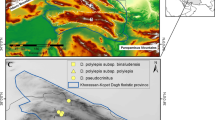Summary
Habitat specialization in populations of three broadly distributed trees includes adaptive differentiation to day length and temperature. Low sensitivity to environmental cues is the adaptive strategy of the southernmost populations (from northeastern Mexico). Early cessation of growth and sensitivity to the environment is adaptive for the northernmost populations (southern Illinois). Intermediate responses characterize trees of Texas. In a comparison under four photoperiod-temperature conditions, the Mexico plants were adapted to the longest growing season. Under out-of-doors conditions in central Texas, these trees from Mexico continue to demonstrate adaptive strategies different from those of Texas or Illinois trees. Stipule production and leaf area inPlatanus showed modifications correlated with latitude. Northernmost trees had the smallest leaves and did not produce stipules under 12-h day lengths and 24–15 °C temperatures. The Mexico trees had stipules under each of the four experimental conditions. The results suggest that populations of deciduous trees in a given climate are selected toward convergence in some responses to that climate. As a result, populations of the three trees resemble each other in behavior in a given ecosystem.
Similar content being viewed by others
References
Adams, R. P. 1969. Chemosystematic and numerical studies in natural populations of Juniperus. Ph. D. Diss., Univ. of Texas, Austin, 240 pp.
Correll, D. S. & M. C. Johnston. 1970. Manual of the vascular plants of Texas. Texas Research Foundation, Renner, Texas. 188 pp.
Demos, E. K., P. Peterson & G. J. Williams. 1973. Frost tolerance among populations of Acer negundo L. Amer. Midl. Nat. 89: 223–228.
Fowells, H. A. 1965. Silvics of the forest trees of the United States. Agric. Handb. 271. U.S. Dept. Agric., Washington. 762 pp.
Hutchinson, G. E. 1958. Concluding remarks. Cold Spring Harbor Symp. Quant. Biol. 22: 415–427.
Kormondy, E. J. 1969. Concepts of ecology. Prentice-Hall, Inc. Englewood Cliffs, New Jersey. 209pp.
Mason, H. L. & J. H. Langenheim. 1957. Language analysis and the concept environment. Ecology 38: 325–340.
McMillan, C. 1959. The role of ecotypic variation in the distribution of the central grassland of North America. Ecol. Monogr. 29: 285–308.
McMillan, C. 1965. Ecotypic differentiation within four North American prairie grasses. II. Behavioral variation within transplanted community fractions. Amer. J. Bot. 52: 55–65.
McMillan, C. & J. T. Peacock. 1964. Bud-bursting in diverse populations of mesquite (Prosopis: Leguminosae) under uniform conditions. Southwest. Nat. 9: 181–188.
Meuli, L. J. & H. L. Shirley. 1937. The effect of seed origin on drought resistance of green ash in the prairie-plains states. J. Forest. 35: 1060–1062.
Priest, R. L. 1971. Ecotypic differentiation in response to freezing in populations of Liquidambar, Platanus, Taxodium and Quercus. M. A. Thesis. Univ. of Texas, Austin. 43 pp.
Rowe, J. S. 1964. Environmental pre-conditioning with special reference to forestry. Ecology 45: 399–403. 480 pp.
Steel, R. G. D. & J. H. Torrie. 1960. Principles and procedures of statistics. McGraw-Hill Book Co., New York. 480 pp.
Steponkus, P. L. & F. C. Lanphear. 1967. Refinement of the triphenyl tetrazolium chloride method of determining cold injury. Plant Physiol. 42: 1423–1426.
Vaartaja, O. 1959. Evidence of photoperiodic ecotypes in trees. Ecol. Monogr. 29: 91–111.
Vaartaja, O. 1961. Demonstration of photoperiodic ecotypes in Liriodendron and Quercus. Can. J. Bot. 39: 649–654.
Westhoff, V. & E. van der Maarel. 1973. The Braun-Blanquet approach. In R. H. Whittaker (ed.) Handbook of Vegetation Science, part V Classification and Ordination of Vegetation, p. 617–726. Junk, The Hague.
Williams, G. J. 1971a. Populational differentiation in the Hill reaction of United States, Mexico and Central America Liquidambar styraciflua L. Photosynthetica 5: 139–145.
Williams, G. J. 1971b. Levels of soluble sugars and ATP in ecotypes of Liquidambar styraciflua L. Photosynthetica 5: 399–405.
Williams, G. J. & C. McMillan. 1971a. Phenology of six United States provenances of Liquidambar styraciflua under controlled conditions. Am. J. Bot. 58: 24–31.
Williams, G. J. & C. McMillan. 1971b. Frost tolerance of Liquidambar styraciflua native to the United States, Mexico and Central America. Can. J. Bot. 49: 1551–1558.
Winstead, J. E. 1968. Ecotypic differentiation in Liquidambar styraciflua L. Ph. D. Diss. Univ. of Texas, Austin. 138 pp.
Winstead, J. E. 1971. Populational differences in seed germination and stratification requirements of sweetgum. Forest Sci. 17: 34–36.
Winstead, J. E. 1972. Fiber tracheid length and wood specific gravity of seedlings as ecotypic characters in Liquidambar styraciflua L. Ecology 53: 165–172.
Yemm, E. W. & E. C. Cocking. 1955. Determination of amino acids with ninhydrin. Analyst 80: 209–216.
Author information
Authors and Affiliations
Additional information
Research funds were provided by a grant from the U.S. Forest Service and from National Science Foundation Grant GB-6097. I acknowledge help of David S. May and George J. Williams.
Rights and permissions
About this article
Cite this article
McMillan, C. Differentiation in habitat response in taxodium distichum, taxodium mucronatum, platanus occidentalis, and liquidambar styraciflua from the United States and Mexico. Plant Ecol 29, 1–10 (1974). https://doi.org/10.1007/BF02390890
Accepted:
Issue Date:
DOI: https://doi.org/10.1007/BF02390890




